7.4.2: Clay Minerals
- Page ID
- 18693
\( \newcommand{\vecs}[1]{\overset { \scriptstyle \rightharpoonup} {\mathbf{#1}} } \)
\( \newcommand{\vecd}[1]{\overset{-\!-\!\rightharpoonup}{\vphantom{a}\smash {#1}}} \)
\( \newcommand{\id}{\mathrm{id}}\) \( \newcommand{\Span}{\mathrm{span}}\)
( \newcommand{\kernel}{\mathrm{null}\,}\) \( \newcommand{\range}{\mathrm{range}\,}\)
\( \newcommand{\RealPart}{\mathrm{Re}}\) \( \newcommand{\ImaginaryPart}{\mathrm{Im}}\)
\( \newcommand{\Argument}{\mathrm{Arg}}\) \( \newcommand{\norm}[1]{\| #1 \|}\)
\( \newcommand{\inner}[2]{\langle #1, #2 \rangle}\)
\( \newcommand{\Span}{\mathrm{span}}\)
\( \newcommand{\id}{\mathrm{id}}\)
\( \newcommand{\Span}{\mathrm{span}}\)
\( \newcommand{\kernel}{\mathrm{null}\,}\)
\( \newcommand{\range}{\mathrm{range}\,}\)
\( \newcommand{\RealPart}{\mathrm{Re}}\)
\( \newcommand{\ImaginaryPart}{\mathrm{Im}}\)
\( \newcommand{\Argument}{\mathrm{Arg}}\)
\( \newcommand{\norm}[1]{\| #1 \|}\)
\( \newcommand{\inner}[2]{\langle #1, #2 \rangle}\)
\( \newcommand{\Span}{\mathrm{span}}\) \( \newcommand{\AA}{\unicode[.8,0]{x212B}}\)
\( \newcommand{\vectorA}[1]{\vec{#1}} % arrow\)
\( \newcommand{\vectorAt}[1]{\vec{\text{#1}}} % arrow\)
\( \newcommand{\vectorB}[1]{\overset { \scriptstyle \rightharpoonup} {\mathbf{#1}} } \)
\( \newcommand{\vectorC}[1]{\textbf{#1}} \)
\( \newcommand{\vectorD}[1]{\overrightarrow{#1}} \)
\( \newcommand{\vectorDt}[1]{\overrightarrow{\text{#1}}} \)
\( \newcommand{\vectE}[1]{\overset{-\!-\!\rightharpoonup}{\vphantom{a}\smash{\mathbf {#1}}}} \)
\( \newcommand{\vecs}[1]{\overset { \scriptstyle \rightharpoonup} {\mathbf{#1}} } \)
\( \newcommand{\vecd}[1]{\overset{-\!-\!\rightharpoonup}{\vphantom{a}\smash {#1}}} \)
\(\newcommand{\avec}{\mathbf a}\) \(\newcommand{\bvec}{\mathbf b}\) \(\newcommand{\cvec}{\mathbf c}\) \(\newcommand{\dvec}{\mathbf d}\) \(\newcommand{\dtil}{\widetilde{\mathbf d}}\) \(\newcommand{\evec}{\mathbf e}\) \(\newcommand{\fvec}{\mathbf f}\) \(\newcommand{\nvec}{\mathbf n}\) \(\newcommand{\pvec}{\mathbf p}\) \(\newcommand{\qvec}{\mathbf q}\) \(\newcommand{\svec}{\mathbf s}\) \(\newcommand{\tvec}{\mathbf t}\) \(\newcommand{\uvec}{\mathbf u}\) \(\newcommand{\vvec}{\mathbf v}\) \(\newcommand{\wvec}{\mathbf w}\) \(\newcommand{\xvec}{\mathbf x}\) \(\newcommand{\yvec}{\mathbf y}\) \(\newcommand{\zvec}{\mathbf z}\) \(\newcommand{\rvec}{\mathbf r}\) \(\newcommand{\mvec}{\mathbf m}\) \(\newcommand{\zerovec}{\mathbf 0}\) \(\newcommand{\onevec}{\mathbf 1}\) \(\newcommand{\real}{\mathbb R}\) \(\newcommand{\twovec}[2]{\left[\begin{array}{r}#1 \\ #2 \end{array}\right]}\) \(\newcommand{\ctwovec}[2]{\left[\begin{array}{c}#1 \\ #2 \end{array}\right]}\) \(\newcommand{\threevec}[3]{\left[\begin{array}{r}#1 \\ #2 \\ #3 \end{array}\right]}\) \(\newcommand{\cthreevec}[3]{\left[\begin{array}{c}#1 \\ #2 \\ #3 \end{array}\right]}\) \(\newcommand{\fourvec}[4]{\left[\begin{array}{r}#1 \\ #2 \\ #3 \\ #4 \end{array}\right]}\) \(\newcommand{\cfourvec}[4]{\left[\begin{array}{c}#1 \\ #2 \\ #3 \\ #4 \end{array}\right]}\) \(\newcommand{\fivevec}[5]{\left[\begin{array}{r}#1 \\ #2 \\ #3 \\ #4 \\ #5 \\ \end{array}\right]}\) \(\newcommand{\cfivevec}[5]{\left[\begin{array}{c}#1 \\ #2 \\ #3 \\ #4 \\ #5 \\ \end{array}\right]}\) \(\newcommand{\mattwo}[4]{\left[\begin{array}{rr}#1 \amp #2 \\ #3 \amp #4 \\ \end{array}\right]}\) \(\newcommand{\laspan}[1]{\text{Span}\{#1\}}\) \(\newcommand{\bcal}{\cal B}\) \(\newcommand{\ccal}{\cal C}\) \(\newcommand{\scal}{\cal S}\) \(\newcommand{\wcal}{\cal W}\) \(\newcommand{\ecal}{\cal E}\) \(\newcommand{\coords}[2]{\left\{#1\right\}_{#2}}\) \(\newcommand{\gray}[1]{\color{gray}{#1}}\) \(\newcommand{\lgray}[1]{\color{lightgray}{#1}}\) \(\newcommand{\rank}{\operatorname{rank}}\) \(\newcommand{\row}{\text{Row}}\) \(\newcommand{\col}{\text{Col}}\) \(\renewcommand{\row}{\text{Row}}\) \(\newcommand{\nul}{\text{Nul}}\) \(\newcommand{\var}{\text{Var}}\) \(\newcommand{\corr}{\text{corr}}\) \(\newcommand{\len}[1]{\left|#1\right|}\) \(\newcommand{\bbar}{\overline{\bvec}}\) \(\newcommand{\bhat}{\widehat{\bvec}}\) \(\newcommand{\bperp}{\bvec^\perp}\) \(\newcommand{\xhat}{\widehat{\xvec}}\) \(\newcommand{\vhat}{\widehat{\vvec}}\) \(\newcommand{\uhat}{\widehat{\uvec}}\) \(\newcommand{\what}{\widehat{\wvec}}\) \(\newcommand{\Sighat}{\widehat{\Sigma}}\) \(\newcommand{\lt}{<}\) \(\newcommand{\gt}{>}\) \(\newcommand{\amp}{&}\) \(\definecolor{fillinmathshade}{gray}{0.9}\)| Clay Minerals | ||||
| illite group | K(Al,Mg,Fe)2(Si,Al)4O10(OH)2•nH2O | |||
| smectite group •montmorillonite •nontronite •beidellite •saponite |
(Na,Ca)0.33(Al,Mg)2Si4O10(OH)2•nH2O Na0.3Fe2(Si,Al)4O10(OH)2•nH2O Na0.5Al2(Si3.5Al0.5)O10(OH)2•n(H2O) Ca0.25(Mg,Fe)3(Si,Al)4O10(OH)2•n(H2O) |
|||
| kaolinite group •dickite •halloysite •nacrite |
Al2Si2O5(OH)4 Al2Si2O5(OH)4 Al2Si2O5(OH)4 |
|||
| related minerals •vermiculite •talc •pyrophyllite |
(Mg,Fe)3(Si,Al)4O10(OH)2•4H2O Mg3Si4O10(OH)2 Al2Si4O10(OH)2 |
|||
The clay minerals include many different species; all are sheet silicates. The sheets comprise tetrahedral layers containing mainly Si and Al, and octahedral layers containing mainly Al, Mg, and Fe. Clays generally contain less potassium than micas. Some clays are hydrous, some having as much as 15 to 20 weight percent (wt %) H2O. Their layered structure and the weak bonding between layers give them a characteristic slippery feel when wet.
The table seen here lists the most common clays. The formulas in the box here are only approximate because clays often contain many elemental substitutions. Major differences between the different clay species are the compositions and stacking order of atomic layers.•
Clay minerals account for nearly half the volume of sedimentary rocks. They are usually very fine grained, often less than 1 μm (10-6 m) in size, have complex chemistries, and are structurally variable. This makes identification of individual clay species difficult. X-ray analysis is often necessary to tell them apart. In contrast with quartz and feldspar, clays do not form in igneous and metamorphic environments.
Clays are common in shales and other sedimentary rocks, but the clay species present depends on the sediment sources. Although usually fine grained, clays can form thick beds or layers. They also develop as coatings on other minerals undergoing weathering. These generalizations are true of all clay minerals, but there is a great deal of variety. In part, the variation is due to the low temperatures at which these minerals form. At high temperatures, minerals and mineral structures tend to be simple and ordered. At low temperatures, structures are often more complex or disordered, and many different mineral varieties may form.
The three most important kinds of clays are illite, montmorillonite, and the clays of the kaolinite group. Figures 7.18, 7.19, and 7.20 show examples of each, but these minerals have many different appearances. Kaolinites, also called kandites, vary less in composition and structure than other clays, although several kaolinite polymorphs (dickite, halloysite, nacrite) are known. Kaolinite is the principal clay used to make ceramic ware because it remains white when fired in a kiln. Illite is quite similar to muscovite in some ways, but contains more Si and less K.
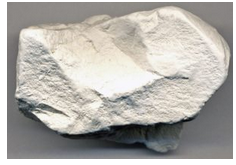
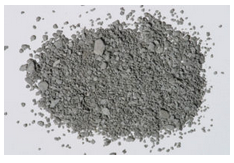
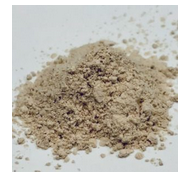
Montmorillonite, which belongs to the smectite group, can take up extra water or other fluids between layers of atoms. In the process the clay expands. So, we sometimes call montmorillonite and other clays of the smectite group expandable or swelling clays. Because they absorb liquids so well, gas station operators use them to clean up spilled oil, and homeowners use them as kitty litter. They are the major components of earthy material called bentonite, sometimes prized for its water-absorbing and cation-exchange properties. Vermiculite, another clay of the smectite group, is often used to lighten up potting soil. Montmorillonite dominates modern clay-rich sediments and sedimentary rocks; illite dominates most sedimentary rocks that are older than about 100 million years. Geologists ascribe this development to ongoing diagenesis, to variations in tectonic activity resulting in changes in sediment sources, and to changes in biological activity.
Clays Used in Industry, Arts, and Ceramics
Many different clays have industrial uses. Clays are widely used to make bricks, tile, paper, rubber, water pipes, and china. They are even used today by some restaurants to thicken milkshakes. Early peoples made bowls and other artifacts by shaping clay and allowing it to dry in the sun.
Today, and in the past, porcelain and china makers commonly use kaolinite for producing their products. If baked to temperatures above 500 °C, kaolinite will dehydrate to metakaolinite (Al2Si2O7), a non-mineral that is relatively hard. Such temperatures can be obtained over open fires, and much early pottery consists of metakaolinite. Although metakaolinite is porous, it will not soften when wetted, in contrast to sun-baked clays.
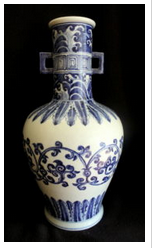
Porcelain refers to a special type of high-grade white ceramic. The Ming vase, seen in this photo (Figure 7.21), is an example. The white color is only possible if the ceramic is made from extremely pure kaolinite. Porcelain is baked, or fired, at very high temperatures. At temperatures of 925 °C and above, metakaolinite converts to a mixture of cristobalite, mullite, and other phases, but it does not melt unless the temperature exceeds 1,600 °C. Prior to firing, small amounts of feldspar or talc are mixed with the kaolinite. When fired at 1,200 to 1,450 °C, the feldspar or talc melt to form a glass, which gives porcelain its glassy luster without melting the kaolinite and destroying the object being made. Porcelain was first developed in China more than 1,000 years ago and slowly moved east through the rest of Asia and to Europe and then the Americas.
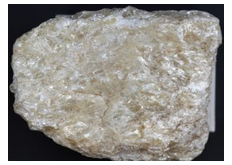
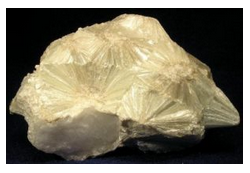
Talc, a secondary mineral that forms when Mg-silicates such as olivine or pyroxene are altered, and pyrophyllite, an uncommon metamorphic mineral, are often grouped with the clays. Figures 7.22 and 7.23 show examples of each. Both are less variable in their atomic arrangements and composition and contain less H2O than true clays. They are transitional between clays and micas in structure and, when seen in hand specimen or thin section, are typically easier to identify than clays. Talc is very soft and has a diagnostic greasy feel that generally makes identification straightforward. In contrast, pyrophyllite often looks like many other white minerals, unless it has the characteristic splay of crystals seen in the photo above (Figure 7.23).


